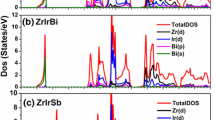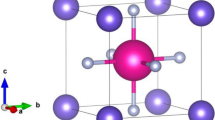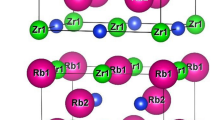Abstract
This work presents structural, elastic, electronic, and thermoelectric properties of a tetragonal Zintl compound RbZn4P3, using the Density Functional Theory and Boltzmann transport equation. The computed structural parameters and bond lengths agree well with available experimental data. We use the density functional perturbation theory approach to obtain the Phonon dispersion curve to prove its dynamical stability. The charge density analysis confirms the coexistence of ionic and covalent bonding in the system. The calculated electronic structure shows the semiconducting nature of RbZn4P3 with a direct bandgap of 1.02 eV using the TB-mBJ approach. We analyze its thermoelectric properties for various hole doping concentrations at different temperatures (300 K-700 K). We obtained a high value of Seebeck coefficient (760.00 μVK−1) at 700 K and (641.72 μVK−1) at 300 K. The lattice thermal conductivity is estimated using Slack’s equation to get the true value of total thermal conductivity. We obtain an ultra-low total thermal conductivity, which in conjunction with high power factor, results in enhanced thermoelectric efficiency or figure of merit (ZT). The maximum ZT value is found to be 0.78 for optimum hole doping concentration of 2 × 1020 cm−3 at 700 K. This study reveals that RbZn4P3 possesses excellent potential as thermoelectric energy harvesting material.
Access this article
We’re sorry, something doesn't seem to be working properly.
Please try refreshing the page. If that doesn't work, please contact support so we can address the problem.








Similar content being viewed by others
References
Tong C (2019) Emerging materials for energy harvesting. Introduction to materials for advanced energy systems. Springer, Cham, pp 719–817
Mori T, Priya S (2018) Materials for energy harvesting: At the forefront of a new wave. MRS Bull 43:176–180. https://doi.org/10.1557/mrs.2018.32
Zareef F, Rashid M, Ahmadini AAH, Alshahrani T, Kattan NA, Laref A (2021) Optoelectronic and thermoelectrical and mechanical properties of CdLu2X4 (X = S, Se) using first-principles calculations for energy harvesting applications. Mater Sci Semicond Process 127:105695. https://doi.org/10.1016/j.mssp.2021.105695
Cai Q, Zhu S (2022) The nexus between vibration-based energy harvesting and structural vibration control: a comprehensive review. Renew Sust Energ Rev 155:111920. https://doi.org/10.1016/j.rser.2021.111920
Safaei M, Sodano HA, Anton SR (2019) A review of energy harvesting using piezoelectric materials: State-of-the-art a decade later (2008–2018). Smart Mater Struct 28:113001. https://doi.org/10.1088/1361-665X/ab36e4
Roknuzzaman M, Ostrikov KK, Wang H, Du A, Tesfamichael T (2017) Towards lead-free perovskite photovoltaics and optoelectronics by ab-initio simulations. Sci Rep 7:1–8. https://doi.org/10.1038/s41598-017-13172-y
Tritt TM, Subramanian MA (2020) Thermoelectric Materials. Phenom Appl A Bird’s Eye View 31:188–197. https://doi.org/10.1557/mrs2006.44
Tan G, Ohta M, Kanatzidis MG (2019) Thermoelectric power generation: From new materials to devices. Philos Trans R Soc A Math Phys Eng Sci 377:20180450. https://doi.org/10.1098/rsta.2018.0450
Bell LE (2008) Cooling, heating, generating heat with and recovering waste thermoelectric. Science 321:1457–1461. https://doi.org/10.1126/science.1158899
Pei Y, Lalonde AD, Heinz NA, Shi X, Iwanaga S, Wang H, Chen L, Snyder GJ (2011) Stabilizing the optimal carrier concentration for high thermoelectric efficiency. Adv Mater 23:5674–5678. https://doi.org/10.1002/adma.201103153
Slack GA (1995) CRC Handbook of thermoelectrics—CRC Press Book. In: Handbook of thermoelectrics
MehdizadehDehkordi A, Zebarjadi M, He J, Tritt TM (2015) Thermoelectric power factor: enhancement mechanisms and strategies for higher performance thermoelectric materials. Mater Sci Eng R Reports 97:1–22. https://doi.org/10.1016/j.mser.2015.08.001
Yang J, Xi L, Qiu W et al (2016) On the tuning of electrical and thermal transport in thermoelectrics: An integrated theory-experiment perspective, npj Comput Mater 2:15015. Doi: https://doi.org/10.1038/npjcompumats.2015.15
Pei Y, Wang H, Snyder GJ (2012) Band engineering of thermoelectric materials. Adv Mater 24:6125–6135. https://doi.org/10.1002/adma.201202919
Rowe DM, Rosi FD (2006) CRC handbook of thermoelectrics: macro to nano
Wright DA (1958) Thermoelectric properties of bismuth telluride and its alloys. Nature 181:834–834. https://doi.org/10.1038/181834a0
Heremans JP, Thrush CM, Morelli DT (2004) Thermopower enhancement in lead telluride nanostructures. Phys Rev B Condens Matter Mater Phys 70:115334. https://doi.org/10.1103/PhysRevB.70.115334
Chen ZG, Shi X, Zhao LD, Zou J (2018) High-performance SnSe thermoelectric materials: progress and future challenge. Prog Mater Sci 97:283–346. https://doi.org/10.1016/j.pmatsci.2018.04.005
Poon SJ (2018) Recent advances in thermoelectric performance of half-heusler compounds. Metals (Basel) 8:989. https://doi.org/10.3390/met8120989
Kauzlarich SM, Brown SR, Jeffrey Snyder G (2007) Zintl phases for thermoelectric devices. J Chem Soc Dalt Trans 21:2099–2107. https://doi.org/10.1039/b702266b
Liu KF, Xia SQ (2019) Recent progresses on thermoelectric Zintl phases: Structures, materials and optimization. J Solid State Chem 270:252–264. https://doi.org/10.1016/j.jssc.2018.11.030
Gascoin F, Ottensmann S, Stark D, Haile S, Snyder GJ (2005) Zintl phases as thermoelectric materials: tuned transport properties of the compounds CaxYb1-xZn2Sb2. Adv Funct Mater 15:1860–1864. https://doi.org/10.1002/adfm.200500043
Chen C, Feng Z, Yao H et al (2021) Intrinsic nanostructure induced ultralow thermal conductivity yields enhanced thermoelectric performance in Zintl phase Eu2ZnSb2. Nat Commun 12:1–9. https://doi.org/10.1038/s41467-021-25483-w
Nesper R (2014) The Zintl-Klemm concept—a historical survey. Zeitschrift fur Anorg und Allg Chemie 640:2639–2648. https://doi.org/10.1002/zaac.201400403
Zhang J, Song L, Mamakhel A, Jorgensen MRV, Iversen BB (2017) High-performance low-cost n-type se-doped mg3sb2-based zintl compounds for thermoelectric application. Chem Mater 29:5371–5383. https://doi.org/10.1021/acs.chemmater.7b01746
Yang G, Yang J, Yan Y, Wang Y (2014) The relationship between the electronic structure and thermoelectric properties of Zintl compounds M2Zn5As4 (M = K, Rb). Phys Chem Chem Phys 16:5661–5666. https://doi.org/10.1039/c3cp54545h
Zevalkink A, Zeier WG, Pomrehn G, Schechtel E, Tremel W, Snyder GJ (2012) Thermoelectric properties of Sr3GaSb3—a chain-forming Zintl compound. Energy Environ Sci 5:9121–9128. https://doi.org/10.1039/c2ee22378c
Azam S, Khan SA, Goumri-Said S (2015) Revealing the optoelectronic and thermoelectric properties of the Zintl quaternary arsenides ACdGeAs2 (A = K, Rb). Mater Res Bull 70:847–855. https://doi.org/10.1016/j.materresbull.2015.05.044
Zheng L, Li W, Sun C, Shi X, Zhang X, Pei Y (2020) Ternary thermoelectric AB2C2 Zintls. J Alloys Compd 821:153497. https://doi.org/10.1016/j.jallcom.2019.153497
Lin Z, Wang G, Le C, Zhao H, Liu n, Hu J, Guo L, Chen X, (2017) Thermal conductivities in NaSnAs, NaSnP, and NaSn2As2: Effect of double lone-pair electrons. Phys Rev B 95:1–7. https://doi.org/10.1103/PhysRevB.95.165201
Guechi N, Bouhemadou A, Medkour Y, Al-Douri Y, Khenata R, Bin-Omran S (2020) Electronic and thermoelectric properties of the layered Zintl phase CaIn2P2: first-principles calculations. Philos Mag 100:3023–3039. https://doi.org/10.1080/14786435.2020.1799101
Feng Z, Yang J, Wang Y, Yan Y, Yang G, Zhang X (2015) Origin of different thermoelectric properties between Zintl compounds Ba3Al3P5 and Ba3Ga3P5: a first-principles study. J Alloys Compd 636:387–394. https://doi.org/10.1016/j.jallcom.2015.02.133
He H, Tyson C, Bobev S (2011) Eight-coordinated arsenic in the Zintl phases RbCd4As 3 and RbZn4As3: synthesis and structural characterization. Inorg Chem 50:8375–8383. https://doi.org/10.1021/ic2009418
Schwarz K, Blaha P, Madsen GKH (2002) Electronic structure calculations of solids using the WIEN2k package for material sciences. Comput Phys Commun 147:71–76. https://doi.org/10.1016/S0010-4655(02)00206-0
Perdew JP, Burke K, Ernzerhof M (1996) Generalized gradient approximation made simple. Phys Rev Lett 77:3865–3868. https://doi.org/10.1103/PhysRevLett.77.3865
Tran F, Blaha P (2009) Accurate band gaps of semiconductors and insulators with a semilocal exchange-correlation potential. Phys Rev Lett 102:5–8. https://doi.org/10.1103/PhysRevLett.102.226401
Madsen GKH, Singh DJ (2006) BoltzTraP. A code for calculating band-structure dependent quantities. Comput Phys Commun 175:67–71. https://doi.org/10.1016/j.cpc.2006.03.007
Xing G, Sun J, Li Y, Fan X, Zheng W, Singh DJ (2017) Electronic fitness function for screening semiconductors as thermoelectric materials. Phys Rev Mater 1:1–13. https://doi.org/10.1103/PhysRevMaterials.1.065405
Kresse G, Furthmüller J (1996) Efficient iterative schemes for ab initio total-energy calculations using a plane-wave basis set. Phys Rev B 54:11169–11186. https://doi.org/10.1103/PhysRevB.54.11169
Togo A, Tanaka I (2015) First principles phonon calculations in materials science. Scr Mater 108:1–5. https://doi.org/10.1016/j.scriptamat.2015.07.021
Mushtaq M, Sattar MA, Dar SA (2020) Phonon phase stability, structural, mechanical, electronic, and thermoelectric properties of two new semiconducting quaternary Heusler alloys CoCuZrZ (Z = Ge and Sn). Int J Energy Res 44:5936–5946. https://doi.org/10.1002/er.5373
Lindsay L, Broido DA, Reinecke TL (2013) First-principles determination of ultrahigh thermal conductivity of boron arsenide: a competitor for diamond? Phys Rev Lett 111:1–5. https://doi.org/10.1103/PhysRevLett.111.025901
Born M, Huang K (1956) Dynamical theory of crystal lattices. Acta Cryst 9:837–838. https://doi.org/10.1107/S0365110X56002370
Hill R (1952) The elastic behaviour of a crystalline aggregate. Proc Phys Soc Sect A 65:349–354. https://doi.org/10.1088/0370-1298/65/5/307
Parvin F, Hossain MA, Ahmed I, Aktr K, Islam AKMA (2021) First-principles calculations to investigate mechanical, optoelectronic and thermoelectric properties of half-Heusler p-type semiconductor BaAgP. Results Phys 23:104068. https://doi.org/10.1016/j.rinp.2021.104068
Anderson OL (1963) A simplified method for calculating the debye temperature from elastic constants. J Phys Chem Solids 24:909–917. https://doi.org/10.1016/0022-3697(63)90067-2
Chandran AK, Gudelli VK, Sreeparvathy PC, Kanchana V (2016) Structural and thermoelectric properties of zintl-phase CaLiPn (Pn=As, Sb, Bi). J Solid State Chem 243:198–206. https://doi.org/10.1016/j.jssc.2016.08.030
Snyder GJ, Toberer ES (2010) Complex thermoelectric materials. Mater Sustain Energy A Collect Peer Rev Res Rev Artic from Nat Publ Gr 7:101–110. https://doi.org/10.1142/9789814317665_0016
Dutta M, Ghosh T, Biswas K (2020) Electronic structure modulation strategies in high-performance thermoelectrics. APL Mater 8:040910. https://doi.org/10.1063/5.0002129
Putatunda A, Xing G, Sun J, Li Y, Singh DJ (2018) Thermoelectric properties of layered NaSbSe 2. J Phys Condens Matter 30:225501. https://doi.org/10.1088/1361-648X/aabf5b
Adebambo PO, Osafile OE, Laoye JA, Idowu MA, Adebayo GA (2021) Electronic fitness function, effective mass and thermoelectric properties of Rh-based (-ScTe; -TiSb; -VSn) alloys for thermoelectric generator applications. Comput Condens Matter 26:e00523. https://doi.org/10.1016/j.cocom.2020.e00523
Slack GA (1979) The Thermal Conductivity of Nonmetallic Crystals. Solid State Phys Adv Res Appl 34:1–71. https://doi.org/10.1016/S0081-1947(08)60359-8
Gupta Y, Sinha MM, Verma SS (2021) First-principles investigation on the electronic, mechanical and lattice dynamical properties of novel AlNiX (X = As and Sb) half-Heusler alloys. Mater Today Commun 26:101885. https://doi.org/10.1016/j.mtcomm.2020.101885
Belomestnykh VN, Tesleva EP (2004) Interrelation between anharmonicity and lateral strain in quasi-isotropic polycrystalline solids. Tech Phys 49:1098–1100. https://doi.org/10.1134/1.1787679
Bessas D, Sergueev I, Wille HC, Person J, Ebling D, Hermann RP (2012) Lattice dynamics in Bi2Te3 and Sb2Te3: Te and Sb density of phonon states. Phys Rev B Condens Matter 86:224301. https://doi.org/10.1103/PhysRevB.86.224301
Acknowledgements
One of the authors (Sangeeta) wish to acknowledge the financial support provided by Delhi Technological University, Delhi for pursuing Ph.D.
Author information
Authors and Affiliations
Corresponding author
Ethics declarations
Conflict of interest
The authors declare that they have no conflict of interest.
Additional information
Handling Editor: M. Grant Norton.
Publisher's Note
Springer Nature remains neutral with regard to jurisdictional claims in published maps and institutional affiliations.
Rights and permissions
About this article
Cite this article
Sangeeta, Kumar, R. & Singh, M. Realizing high thermoelectric performance in p-type RbZn4P3 Zintl compound: a first-principles investigation. J Mater Sci 57, 10691–10701 (2022). https://doi.org/10.1007/s10853-022-06953-y
Received:
Accepted:
Published:
Issue Date:
DOI: https://doi.org/10.1007/s10853-022-06953-y




